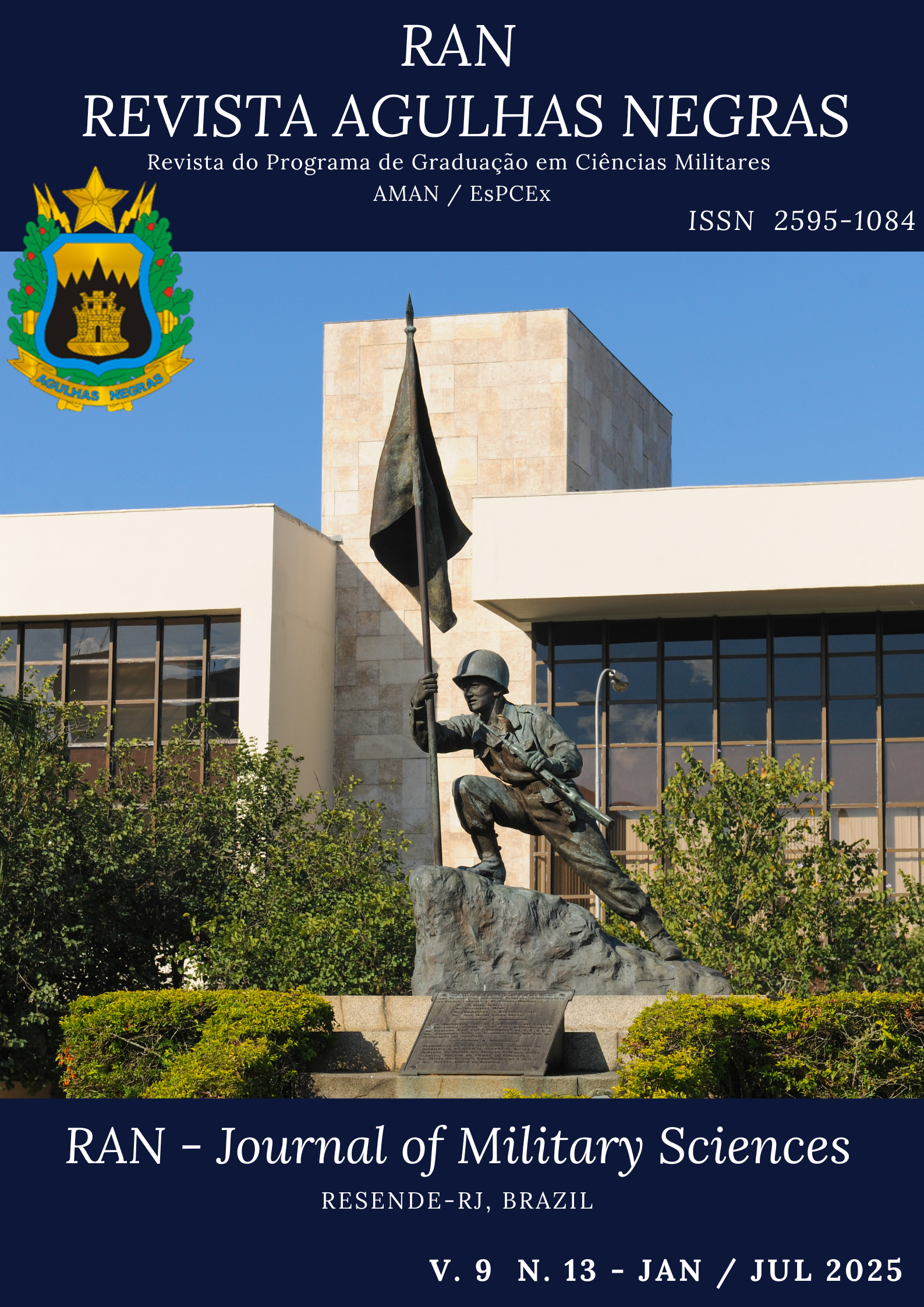Chaos Theory and Military Decision-Making Process
exploring new paradigms for the art of war
DOI:
https://doi.org/10.70545/ran.v9i13.12918Keywords:
Chaos Theory., Art of War., Chaosplex., Modeling.Abstract
The perennial phenomenon of war creates a permanent possibility for the emergence of imponderables of various shades in the conflict area, forming the chaotic set that exists in any Theater of Operations. Chaos Theory is one of the most important scientific studies today, with applications in practically all areas of human knowledge, including the Art of War. This article explores how Chaos Theory can be applied to Military Doctrine, indicating its relevance for the evolution of the Art of War. The objective is to theorize about the application of Chaos Theory in Military Doctrine, exploring how its principles can be integrated into the decision-making process, and how this can contribute to the evolution of the Art of War. To this end, Torres' work, in “Complexity Theory: A New Worldview for Strategy”, is important for clarifying points of Chaos Theory. Regarding the applicability of Chaos Theory to the Art of War, Kolenda proves to be crucial in his work: Transforming How We Fight: A Conceptual Approach. The military manual MD35-10-G.102: Glossary of the Armed Forces, of Brazil, defines terms relevant to this work. The research is based on a theoretical review that connects principles of chaos to aspects of military doctrine, providing a new perspective on adaptation and response to situations of uncertainty and complexity of non-linearity in the Theater of Operations.
Downloads
References
BEYERCHEN, A. Chaos Theory and Strategic Thought. Parameters, v. 22, n. 3, p. 26-37. Pensilvania: U.S. Army War College Press, 1992. DOI: https://doi.org/10.55540/0031-1723.1634
BORGES DE MACEDO, P. E. V. A guerra e a violência na política em Clausewitz / Clausewitz’ war and violence in politics. REVISTA QUAESTIO IURIS, vol. 11, n. 04, p. 2916–2947, 2018. Disponível em: https://doi.org/10.12957/rqi.2018.37233. Acesso em: 04 abr. 2024. DOI: https://doi.org/10.12957/rqi.2018.37233
BOUSQUET, A. The Scientific Way of Warfare. Londres: Hurst Publishers, 2009. 288 p.
BRASIL. MD35-10-G.102: Glossário das Forças Armadas. 5ª. Ed. Brasília. [s.n]. 2015.
FEDER, J., Fractals, New York: Plenum Press, 1988, 325 p. DOI: https://doi.org/10.1007/978-1-4899-2124-6
FERREIRA, R. Watson & Crack: a história da descoberta do DNA. São Paulo: Odysseus, 2003. 132 p.
FUQUA, D. O. Understanding the Role of Chaos Theory in Military Decision Making. 2009, 54 p. Dissertação (Mestrado em Advanced Military Studies) - School of Advanced Military Studies, 54 p., Fort Leavenworth, KS, 2009.
GUINDO, M. G.; MARTÍNEZ, G.; & GONZÁLEZ, V. La Guerra Híbrida: nociones preliminares y su repercusión em el planeamiento de los países y organizaciones occidentales. Granada: Instituto Español de Estudios Estratégicos, 2015. 36 p.
HEISENBERG, W. The physical content of quantum kinematics and mechanics. In: WHEELER, J. A.; ZUREK, W. H. (org.). Quantum theory and measurement. Princeton: Princeton University Press, 1983. p. 62-84.
KOLENDA, C. D. TRANSFORMING HOW WE FIGHT: A Conceptual Approach. Naval War College Review, vol. 56, n. 2, primavera 2003, p. 100–122. Disponível em: http://www.jstor.org/stable/26393987. Acesso em: 14 mar. 2024.
LORENZ, E. N. Deterministic nonperiodic flow. Journal of atmospheric sciences, v. 20, n. 2, p. 130-141, mar. 1963. DOI: https://doi.org/10.1175/1520-0469(1963)020<0130:DNF>2.0.CO;2
MANDELBROT, B. B. Rev. The fractal geometry of nature, San Francisco: WH Freeman.1982, 504 p.
MARIETTO, M. L., SANCHES, C., & MEIRELES, M. TEORIA DO CAOS: UMA CONTRIBUIÇÃO PARA A FORMAÇÃO DE ESTRATÉGIAS. Revista Ibero Americana de Estratégia, vol. 10, n. 3, p. 66-93, setembro-dezembro 2011. Disponível em https://www.redalyc.org/articulo.oa?id=331227120005. Acesso em: 15 mai. de 2023. DOI: https://doi.org/10.5585/riae.v10i3.1757
MARINHO, L. L., et al. Caos em circuitos elétricos: uma abordagem inicial. Revista do Professor de Física, v. 6, n. 1, p. 46-68, 2022. DOI: https://doi.org/10.26512/rpf.v6i1.40597
MARQUEZI, D. Edward Norton Lorenz – O Criador da Teoria do Caos. Revista Época, [s.d.] 2008.
PAINE, E., DIETRIK, K. WARSIM Enters the Scene in Army Training, The Journal of Defense Software Engineering, p. 12-13, setembro de 2015. Disponível em: https://apps.dtic.mil/sti/tr/pdf/ADA489499.pdf. Acesso em: 16 de abr. de 2024.
POINCARÉ, J. H. Les methodes nouvelles de la Mécanique Céleste, Paris: Gauthier-Vilars, 1899. 408 p. DOI: https://doi.org/10.1007/BF02742713
ROSEN, S. M. The Self-Evolving Cosmos: A Phenomenological Approach to Nature's Unity-in-Diversity. Albany: State University of New York Press, 2008. 290 p. DOI: https://doi.org/10.1142/9789812771742
SHARP, G. Poder, luta e defesa: Teoria e prática da ação não-violenta. Tradução: Getulio Bertelli. São Paulo: Edições Paulinas, 1983. 274 p.
STROGATZ, S. H. Nonlinear dynamics and chaos with student solutions manual: With applications to physics, biology, chemistry, and engineering. Flórida: CRC press, 21 set. 2018. DOI: https://doi.org/10.1201/9780429399640
TOLK, A. Engineering Principles of Combat Modeling and Distributed Simulation. Hoboken, Nova Jersey: Wiley Library, 2012. 944 p. DOI: https://doi.org/10.1002/9781118180310
TÔRRES, J. J. M., Teoria da complexidade: uma nova visão de mundo para a estratégia, In I EBEC, 2005, Curitiba. Anais. Curitiba: PUC/PR, 2005, p. 1-10.
TZU, S. A arte da guerra: Os treze capítulos originais. São Paulo: Jardim dos Livros, 2007. 248 p.
VON CLAUSEWITZ, C. Da guerra. São Paulo: WWF Martins Fontes, 2017. 881 p.









